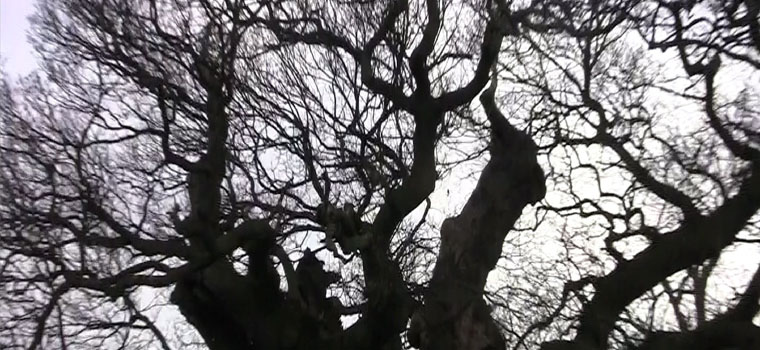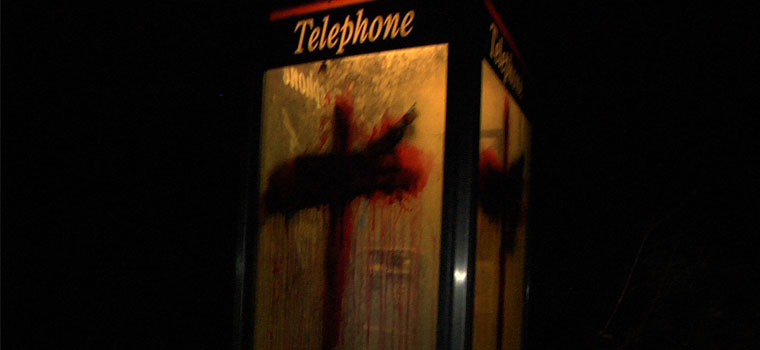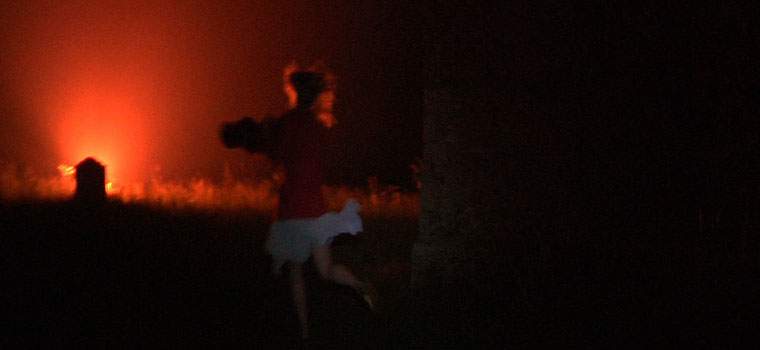THE HANGING TREE
THE HANGING TREE: Folklore and Foreboding in Michael Axelgaard and Matthew Holt’s HOLLOW
Kier-La Janisse
——————–
First-time feature filmmakers Michael Axelgaard and Matthew Holt follow up their short film The Lollipop Man (2009) with shuddery rural reality-horror flick Hollow, playing as part of this year’s Playback in Black: The Next Wave showcase.
When four twenty-somethings – engaged couple Emma and Scott, Emma’s best friend James and his latest squeeze Lynne – embark on a weekend double date at the remote cottage of Emma’s dead vicar grandfather, the last thing they expect is to be plunged into a candle-lit hellride through relationship psychosis, stalked by an unseen entity that haunts the nearby ruins. Emma’s trepidation as they drive past the huge, gnarled tree outside the property kicks off an evening of mysterious ghost tales, night terrors and panic attacks. But fear of the unknown elements of the local folklore aren’t their only problem; the weekend is a trap in another manner altogether, as friends and partners are pitted against eachother in an increasingly competitive relationship dynamic.
Spectacular Optical spoke to the filmmakers on the eve of their World Premiere about the convergence of folklore and technology, and levitra show pill the chills that can still be effectively mined from reality-horror.
——————–
This is your first feature film, buy levitra in india although you worked together on a short film previously. Can you tell me about your collaborative process?
Michael and I come from different ends of the spectrum in terms of our interests. Michael is very much genre-oriented, free sample pack of cialis horror and science fiction whilst I am more drama-focused. We devised this project as a vehicle to leverage our respective strengths, building on our previous collaboration on shorter projects.
Where are the tree and the ruins from the film located?
The tree is the oldest and largest oak in England, and was mentioned in the Domesday Book in 1086. We have been asked to keep its destination quiet, so that it doesn’t attract the ‘wrong type’ of attention.
The monastery, cliff and beach scenes where all filmed in Dunwich, on the Suffolk coast. Around 1600, Dunwich was the http://www.spectacularoptical.ca/2021/03/cheap-discount-levitra/ second biggest port in England and also a large religious center. Over time, however, it fell into ruin as the sea eroded more than a mile of coastline. Hundreds of churches and entire villages fell into the sea, earning the area the title of ‘Britain’s Atlantis’. In fact, local legend has it that the bells of churches can still be heard ringing beneath the waves when the sea is calm.
The primary monastery featured is called Greyfriar’s Monastery, though some of neighbouring Leiston Abbey is in the film as well. Greyfriar’s has its own extensive history of ghost stories and legends. It is said on quiet nights one can hear long-dead monks chanting in the deserted cloisters.
Was the film inspired by specific regional folklore? Were the books of medieval art and exorcisms used in the film real?
Most of the material was real, though we did add a few fictional elements.
Suffolk is rich in myth and legend, many springing from its time as a major religious centre in the Middle Ages. The countryside is littered with the ruins of monasteries and churches, abandoned or destroyed at the time of the founding of the Church of England. This was a time of vicious persecution of the monks, many of whom were forced to renounce their faith and marry, or be hung, drawn, and quartered for treason.
With the area’s rich history to work from, much of Hollow’s story leapt fully formed from the ancient evils and gruesome deeds of Suffolk’s isolated landscape and ruins.
In talking about how certain places become suicide destinations, one of the characters says that there’s “a weird sense of camaraderie about it”. Can you elaborate on this sentiment? Do you believe there are places that can tap into your negative energy and actualize negative impulses?
The line in the film is about an infamous place in London near my (Matt’s) home, where people jump from a bridge – about 15 people die each year jumping from that bridge. It has amazing views over London and a long drop to the road beneath. It is known locally as ‘Suicide Bridge’. Anyway, in terms of negative energy, in which direction the causal arrow lies is quite difficult to say. Do people go to this bridge to commit suicide because there is an inherent negative energy which draws them there, or is the negative energy created in the minds of people by its association with the hundreds of preceding deaths?
There are a number of disturbing lines of thought one could go down with this. Has that bridge become a portal, a door created by people passing through, or does it merely exist in the collective psyche of those who choose to step through, that they feel a kinship with others that have gone before. This is one of the questions that we raised in the film, is an entity weaving a web, into which the hapless four unknowingly wander, an evil whose modus operandi is bending the thoughts of those who come close, in the way a poltergeist might blow a candle. Or, do the proceeding deaths create the idea of a portal in the mind of the main character? Can an idea in the mind of a person or people be evil in itself? Maybe evil exists only in the mind of man and there is nothing supernatural at all, but nonetheless, it is a self perpetuating evil.
What was the attraction of a suicide angle in particular? I read that in that in East Anglia suicides are traditionally buried beside the road, is that true?
I haven’t heard about roadside burials in East Anglia, but strange things do happen in some desolate villages!
Suicide is an uncomfortable subject that society, probably quite rightly, shuns, and so immediately provides a macabre backdrop to the film. There are a number of documented instances of group suicides, particularly among the young. While it is easier to deal with the thought of suicide in abstract, when you get to know the characters, it is a different matter, and so this raises the stakes for our protagonists. We hope the movie serves a cautionary tale of how vulnerable minds can be misled and deceived.
The camera is the light, it’s their means of seeing in the dark, and yet everything is obscured by the camera. It doesn’t pick up enough light, and it doesn’t have peripheral vision, so it really limits what we can see as the audience. Can you comment on this ironic use of the camera?
A fundamental horror construct is the idea of something you can’t see creeping up behind you. The tunnel vision of the camera in the dark augments this effect and makes you feel like “behind you” is all around you.
We also wanted the light to become a scarce resource that becomes a source of conflict for the characters, who in the end, fight over the last of the camera light in their struggle to survive.
Elsewhere in the film, we used the camera as a window into the psychology of the characters. James in particular becomes a sort of “unreliable narrator” who at times uses the camera to “self edit” and alter the reality of the weekend into one he finds more easy to face.
Was this approach just the logical way to shoot the film based on the script or did the script get adjusted to accommodate the filmmaking style?
I think that it was a happy coincidence. We set out to create a modern suspense/ horror using a traditional British ghost story imbued with myth and legend with theatrical release potential. We have used the point of view style (or ‘first person dynamic’) as a device to give the film intimacy and immediacy. By using the ‘first person dynamic, and focusing on strong character development, we have sought to draw the viewer into the world of the characters, and make them feel like the fifth member of the group.
The performances in the film were very believable, especially as things started breaking down and the dynamic became very tense, hostile, competitive, manipulative. One reviewer even referred to it as ‘Blair Witch meet Who’s Afraid of Virginia Woolf’! Can you tell me about the casting?
The casting process was a long and arduous one, but the production team knew that to make this kind of movie work, high calibre acting would be the key. Not only because the film is character driven, but also because the use of a single camera meant a reliance on long ‘golden’ takes, and considerable acting ability would be needed to carry this off. Fortunately, the UK has an abundance of great young acting talent from which to draw.
We went in search of up and coming actors, with great talent, but sufficient anonymity that the realism of the piece was not compromised with familiar faces.
—————
HOLLOW has its World Premiere on July 31 at 9:30pm and screens again on Aug. 1 at 3pm in the Salle JA DeSeve with Director Michael Axelgaard and Screenwriter/Producer Matthew Holt in person. More on the film page HERE.

 July 31, 2011
July 31, 2011  No Comments
No Comments





